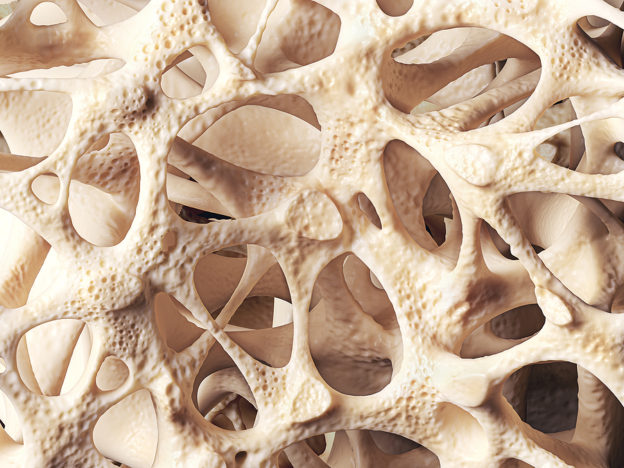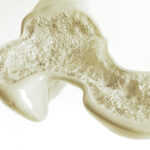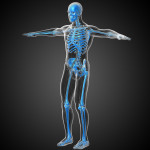By David Blyweiss, M.D., Advanced Natural Wellness
April 23, 2021
In my early days of elementary school, there was a spot in the day where we sang songs. Pop goes the Weasel, Skip to my Lou; silly stuff like that.
But there’s one song that actually had a little educational value to it. Do you remember Dem Bones?
“Your toe bone’s connected to your foot bone… Your foot bone’s connected to your heel bone and so on.” Right?
Then it goes on about how “dem dry bones” are going to walk around.
Well good luck with that! That’s where any educational value ends, because dem dry bones aren’t going to get anybody very far.
Live bone is actually moist and a little bit soft. It’s constantly being broken down and replaced. This makes your bones strong and flexible, so they can handle weight and pressure without snapping.
MD Exposes the Hidden Danger to Your Eyes

When your eyesight starts to fail, it's a real problem. Suddenly you can't go to the grocery store... you can't get to the doctor if you have an emergency... you can't meet your friends for dinner…
Your "regular" doctor doesn't have time to keep up with the latest research. And the same goes for eye doctors. They go to school to learn how to fit you for glasses and contacts, but have no way of preventing the damage and loss of eyesight that threatens your freedom and independence.
Let me show you something that explains a LOT about how your eyes work.
In my FREE Special Report, I'll show you a HUGE, untapped resource for your eyes that safely and naturally restores clear, effortless eyesight.
Click here to get started...
As we age, especially women (but men aren’t immune), we reach the point where old bone breaks down faster than it’s being replaced. The result is osteoporosis… weak, brittle bones that break and fracture easily.
Of course, there are drugs for that.
Do These Meds Cure Osteoporosis?
You’ve got the bisphosphonates. Fosamax, Boniva, Actonel and Reclast fall in this category. They decrease the speed at which bone is broken down.
That sound good in theory, doesn’t it? But if old bone doesn’t get broken down, how can it get replaced with new bone? So these meds stop bone loss in old bone, but do nothing to build strong and healthy new bone. How can that be a good thing?
Disproportionately, some of the side effects are esophageal inflammation, stomach problems, heartburn, nausea and abdominal pain. There can also be bone loss in the jaw, where cells in the jawbone die. These are not nice side effects.
There’s a newer drug out there for people who just can’t tolerate the side effects of bisphosphonates. Denosumab, which includes Prolia and Xgeva. You get a shot every six months.
But its side effects are just as bad. Maybe even worse.
You have to watch your blood levels of calcium and for signs of low calcium (hypocalcemia), like muscle spasms, tingling around your mouth and tingling in your extremities. And for some reason you have an increased risk of infection. So you have to be careful if you get any sort of fever, painful urination, or redness or swelling anywhere on your skin.
There’s also an issue with unusual fractures of the femur. And then you’ve got bone loss in the jaw. That’s similar to one of the side effects of bisphosphonates.
The World's Quickest Solution for Ending Prostate and Urinary Misery
This has recently been revealed to be one of the only real breakthroughs in prostate health.
The seeds of a strange fruit (sometimes called "Chinese Apples") hold powerful phytonutrients that are a revolution in prostate health.
In fact, UCLA and Veterans Administration research have now proved this to be true.
Not only that, but it may be the worlds quickest solution for ending prostate misery.
Simply stated, these phytonutrients represent a huge step beyond beta sitosterol, saw palmetto, and other phytosterols alone.
Simply click HERE if you want to have fast prostate relief...restful, uninterrupted sleep...no more constant "urges to go"...enhanced virility...and optimal prostate support for life.
A new osteoporosis drug, romosozumab (Evenity) blocks a protein in the body that stops bone formation and increases its breakdown. It involves getting two back-to-back shots every month for a year, then treatment stops. That’s because the bone-forming effect wears off after 12 doses.
And this one comes with a black box warning. In addition to other side effects, it can increase the risk of myocardial infarction, stroke and cardiovascular death. That’s just terrible.
And despite all of the horrible side effects, not a single one of them actually “cures” osteoporosis.
So it’s a good thing there are some easy things you can do to improve your bone strength and density without these harmful meds.
Build Strong Bones the Same Way You Build Strong Muscle
A lot of people think bone health is all about vitamin D and calcium. Magnesium and vitamin K, too.
Yes, these are all important. You need to make sure you’re getting enough of them.
But just like you put stress on a muscle to make it bigger and stronger, you have to put stress on the bone.
Weight-bearing activities are great. These involve activities where your bones support your weight. Things like walking, climbing stairs, chair squats and dancing. They all “exercise” the bones in your legs, hips and spine to stave off mineral loss and help them remain strong and flexible.
But don’t neglect the upper body. There are a lot of upper body activities you can do with a resistant band, dumbbells or a medicine ball. Or you can use your own body weight to do things like wall push-ups.
If you need some help figuring out which kinds of exercises will work for you, check this out.
These activities work on your bones much the same way as they do your muscles – making them stronger and more able to support your body for everyday activities.
Just keep dem old bones moving!
P.S. If you’re a woman, I also recommend a little bit of bioidentical hormone therapy. I haven’t had a menopausal female not reverse osteoporosis while taking a natural product. Just keep in mind that insurance won’t pay for it.
SOURCES:
Kennel KA, et al. Adverse effects of bisphosphonates: implications for osteoporosis management. Mayo Clin Proc. 2009;84(7):632-638.
Benlidayi IC, et al. Oral bisphosphonate related osteonecrosis of the jaw: a challenging adverse effect. ISRN Rheumatol. 2013;2013:215034.
Diker-Cohen T, et al. Risk for Infections During Treatment With Denosumab for Osteoporosis: A Systematic Review and Meta-analysis. J Clin Endocrinol Metab. 2020 May 1;105(5):dgz322.
Pittman K, et al. Denosumab: Prevention and management of hypocalcemia, osteonecrosis of the jaw and atypical fractures. Asia Pac J Clin Oncol. 2017 Aug;13(4):266-276.
Fixen C, et al. Romosozumab: a Review of Efficacy, Safety, and Cardiovascular Risk. Curr Osteoporos Rep. 2021 Feb;19(1):15-22.







